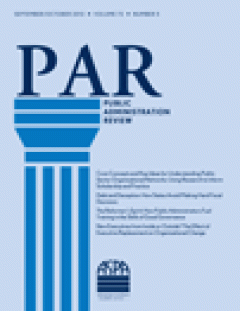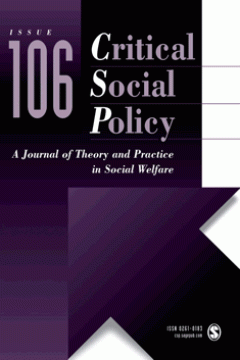Filter by

Understanding Business Improvement Districts : A New Governance Framework
What is the current state of research on business improvement districts (BIDs)? What is an appropriate framework for analysis? What are key questions for advancing future BID research? BIDs can be understood best within a network governance framework. The research shows, first, a blurring of the line between the public and private spheres as a result of BIDs; second, BIDs are increasingly impor…
- Edition
- Volume 70, Issue 6, November/December 2010, pages
- ISBN/ISSN
- 00333352
- Collation
- -
- Series Title
- Public Administration Review
- Call Number
- -

The Latin American Left's Mandate : Free-Market Policies and Issue Voting in …
The rise of the left across Latin America is one of the most striking electoral events to occur in new democracies during the last decade. Current work argues either that the left's electoral success stems from a thoroughgoing rejection of free-market policies by voters or that electorates have sought to punish poorly performing right-wing incumbents. Whether the new left has a policy or perfor…
- Edition
- Volume 63, Issue 01, January 2011. pp 43 -77
- ISBN/ISSN
- 00438871
- Collation
- -
- Series Title
- World Politics
- Call Number
- -

Gonna Party Like It's 1899 : Party Systems and the Origins of Varieties of Co…
This article explores the origins of peak employers' associations to understand why countries produce highly centralized macrocorporatist groups, weaker national associations but stronger industry-level groups, or highly fragmented pluralist associations. The authors suggest that the structure of partisan competition played a vital causal role in the development and evolution of these peak asso…
- Edition
- Volume 63, Issue 01, January 2011. pp 78 -114
- ISBN/ISSN
- 00438871
- Collation
- -
- Series Title
- World Politics
- Call Number
- -

Regimes of Ethnicity : Comparative Analysis of Germany, the Soviet Union/Post…
How do state policies that regulate the relationship between ethnicity and nationality change? This article examines the dynamics of persistence and change in state policies toward ethnicity. In order to better comprehend the nature of political contestation over these state policies, the author first develops a new typology, “regimes of ethnicity,” and categorizes states as having monoethnic, …
- Edition
- Volume 63, Issue 01, January 2011. pp 115 -164
- ISBN/ISSN
- 00438871
- Collation
- -
- Series Title
- World Politics
- Call Number
- -

Electoral Reform and Public Policy Outcomes in Thailand : The Politics of the…
How do changes in electoral rules affect the nature of public policy outcomes? The current evidence supporting institutional theories that answer this question stems almost entirely from quantitative cross-country studies, the data of which contain very little within-unit variation. Indeed, while there are many country-level accounts of how changes in electoral rules affect such phenomena as th…
- Edition
- Volume 63, Issue 01, January 2011. pp 165 -202
- ISBN/ISSN
- 00438871
- Collation
- -
- Series Title
- World Politics
- Call Number
- -

Approaches to health provision in the age of super-diversity: Accessing the N…
Commentators have argued that we have entered a new era of migration described by Vertovec as a ‘transformative diversification of diversity’. Multiple variables of difference in the ethnicity, immigration status, rights and entitlements, age and gender profiles and patterns of distribution, of new migrants mean that the UK, and many other EU countries, are now home to the most diverse populati…
- Edition
- Vol. 31 no. 1, February 2011.pp. 5-29
- ISBN/ISSN
- 02610183
- Collation
- -
- Series Title
- Critical Social Policy
- Call Number
- -

Dilemmas of institutionalization in the penal voluntary sector
The award in 2009 of contracts to operate private prisons to consortia which included charities has reignited debates in the UK about the costs of state patronage among the voluntary sector. This article argues that the controversy has highlighted current dilemmas of institutionalization arising from the interpenetration of civil and penal spheres, as public policy nurtures an emergent ‘penal v…
- Edition
- Vol. 31 no. 1, February 2011.pp. 30-52
- ISBN/ISSN
- 02610183
- Collation
- -
- Series Title
- Critical Social Policy
- Call Number
- -

Fighting for life : Health care and democracy in capitalist Poland
This paper discusses the social and political processes health care transformation in postcommunist Europe has involved in practice. It begins by suggesting a theoretical framework for the study of postcommunist welfare. Focusing on Poland, it examines what lies behind the frictions which have become an integral feature of health care change, which most recently has centred on the privatization…
- Edition
- Vol. 31 no. 1, February 2011.pp. 53-76
- ISBN/ISSN
- 02610183
- Collation
- -
- Series Title
- Critical Social Policy
- Call Number
- -

Substitution and Supplementation Between Co-Functional Policy Instruments : E…
Governments often use multiple policy instruments for pursuing policy goals with mutually reinforcing effects. These effects include supplementation and substitution. This article examines both effects by studying two instruments of state budget stabilization policy: general fund balances and budget stabilization funds. States normally maintain budget surpluses in the general fund. In recent de…
- Edition
- Volume 70, Issue 6, November/December 2010. pages
- ISBN/ISSN
- 00333352
- Collation
- -
- Series Title
- Public Administration Review
- Call Number
- -

A Great and Revolutionary Law? The First Four Years of India’s Right to Inf…
India’s 2005 Right to Information Act (RTIA) is among dozens of national laws recently adopted similar to the U.S. Freedom of Information Act. Drawing on several large studies examining the act’s implementation, the author finds that Indian citizens filed about 2 million requests for information under the RTIA during its first two and half years. However, use of the law was constrained by uneve…
- Edition
- Volume 70, Issue 6, November/December 2010, pages
- ISBN/ISSN
- 00333352
- Collation
- -
- Series Title
- Public Administration Review
- Call Number
- -

Implementing Change in an Urban School District : A Case Study of the Reorgan…
In July 2005, the Little Rock, Arkansas, school district implemented a new policy to reorganize its management structure in order to create a more efficient bureaucracy. Using Richard Matland’s ambiguity-conflict model of policy implementation, the authors examine the implementation of this school reorganization policy. Interviews and surveys were conducted with the superintendent and his execu…
- Edition
- Volume 70, Issue 6, November/December 2010, pages
- ISBN/ISSN
- 00333352
- Collation
- -
- Series Title
- Public Administration Review
- Call Number
- -

Demographic Change and Its Public Sector Consequences
It is widely believed that projected changes in the age structure of the U.S. population will create serious fiscal pressures at the federal level. Irrespective of any reforms undertaken at the federal level, these demographic trends also will have a direct impact on the way state and local governments operate. A review of recent population projections to 2020 reveals a great deal of heterogene…
- Edition
- Volume 70, Issue Supplement s1, December 2010, pag
- ISBN/ISSN
- 00333352
- Collation
- -
- Series Title
- Public Administration Review
- Call Number
- -

Public Budgeting in 2020 : Return to Equilibrium, or Continued Mismatch betwe…
Public budgeting in 2010 is dominated, at all levels of government, by continuing high demands for government services and large budget deficits. Looking ahead to 2020, these struggles are likely to continue. The federal government’s 10-year budget outlook is bleak, and its longer-term outlook is even more dismal, driven by growth in health care costs. State and local government budgets will sl…
- Edition
- Volume 70, Issue Supplement s1, December 2010, pag
- ISBN/ISSN
- 00333352
- Collation
- -
- Series Title
- Public Administration Review
- Call Number
- -

Governing on the Edges : Globalization of Production and the Challenge to Pub…
Globalization means many things for governments around the world in terms of governance. Questions that are left unexplored in the public administration literature are what changes in the globalization of production mean for governments and their relationships with business and civil society, and what the implications are for public administration. The authors develop a conceptual framework tha…
- Edition
- Volume 70, Issue Supplement s1, December 2010, pag
- ISBN/ISSN
- 00333352
- Collation
- -
- Series Title
- Public Administration Review
- Call Number
- -

Administration without Borders
To thrive in 2020, we must conceive of the field of public administration in the broadest possible terms. Phenomena that typically have been treated peripherally in our literature are emerging center stage in recent years, confirming that the “old” boundaries of our discipline do not reflect contemporary reality. After reviewing three key developments—the rise of mixed and nongovernmental insti…
- Edition
- Volume 70, Issue Supplement s1, December 2010, pag
- ISBN/ISSN
- 00333352
- Collation
- -
- Series Title
- Public Administration Review
- Call Number
- -

The Rise and Fall of Discipline : Economic Globalization, Administrative Refo…
Throughout the era of economic liberalization (1978–2007), a significant amount of governmental power was transferred to technocrat-guardians who were carefully buffered from elected officials. Democratic processes, it was said, had to be disciplined through such reforms if nations were to thrive in a globalized economy. This way of thinking about reform was already under assault before the fin…
- Edition
- Volume 70, Issue Supplement s1, December 2010, pag
- ISBN/ISSN
- 00333352
- Collation
- -
- Series Title
- Public Administration Review
- Call Number
- -

Minnowbrook IV in 2028 : From American Minnowbrook to Global Minnowbrook
The first Minnowbrook Conference in 1968 was a big success. The ideas and directions that the field of public administration followed later on were very much influenced by the spirit of Minnowbrook I. Since then, it has become a practice for American scholars in the field of public administration to meet every 20 years to discuss the future direction of the field. Thus, we had Minnowbrook II in…
- Edition
- Volume 70, Issue Supplement s1, December 2010, pag
- ISBN/ISSN
- 00333352
- Collation
- -
- Series Title
- Public Administration Review
- Call Number
- -

Leading in the Shared-Power World of 2020
Imagine that citizens and public officials working together over the next decade are able to maximize the democratic potential of today’s shared-power, “no-one-in-charge” world and achieve more sustainable modes of living together on Earth. The article focuses on the development of shared or collaborative approaches to leadership, ideas for developing integrative leadership practices that harne…
- Edition
- Volume 70, Issue Supplement s1, December 2010, pag
- ISBN/ISSN
- 00333352
- Collation
- -
- Series Title
- Public Administration Review
- Call Number
- -

Sustainability as a Conceptual Focus for Public Administration
This article argues that sustainability should define the conceptual focus for the field of public administration in the coming decade. Sustainability involves three systems: environmental, economic, and political/social systems. The challenge of governance, and thus of public administration, is to sustain each of these systems on its own while maintaining an appropriate balance among them. The…
- Edition
- Volume 70, Issue Supplement s1,December 2010, page
- ISBN/ISSN
- 00333352
- Collation
- -
- Series Title
- Public Administration Review
- Call Number
- -

Ecological Governance : Organizing Principles for an Emerging Era
The significant reforms being implemented in governance systems around the world reflect a broader transition of society from the modern to a new emerging era. This transition is framed in terms of a shift from a mechanistic to an ecological worldview, stimulated by a number of developments during the twentieth century and the last decade. In contrast to the mechanistic orientation toward reduc…
- Edition
- Volume 70,Supplement s1,December 2010,pages s89–s9
- ISBN/ISSN
- 00333352
- Collation
- -
- Series Title
- Public Administration Review
- Call Number
- -
 Computer Science, Information & General Works
Computer Science, Information & General Works  Philosophy & Psychology
Philosophy & Psychology  Religion
Religion  Social Sciences
Social Sciences  Language
Language  Pure Science
Pure Science  Applied Sciences
Applied Sciences  Art & Recreation
Art & Recreation  Literature
Literature  History & Geography
History & Geography